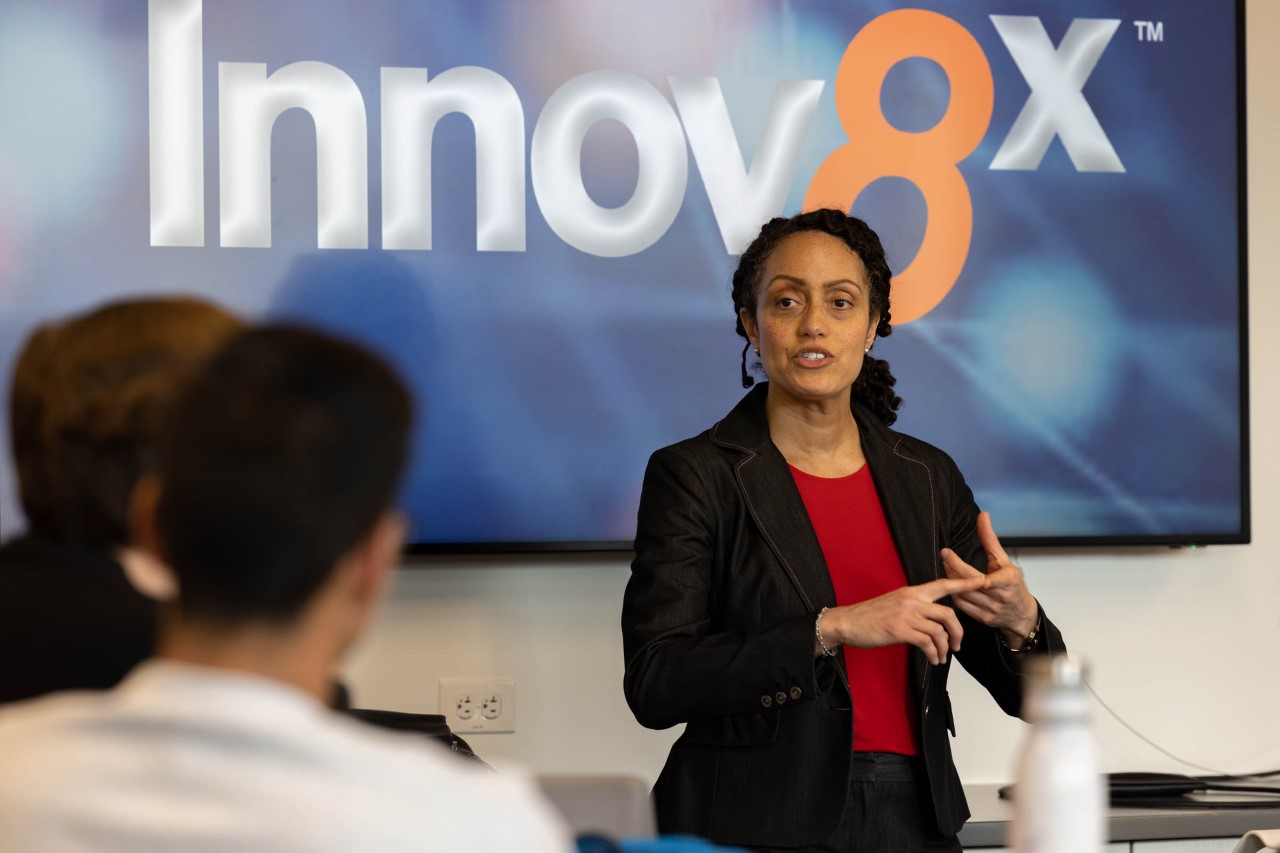Gain Real Skills by taking on Real Problems for Real Beneficiaries.
Investigate, Build, and Create Real Impact.
Why Innov8x?
Land Your Dream Job or Internship
Many Past Innov8x students have received internships and jobs directly from their problem sponsors, or have received a job because of their Innov8x project.
Work on open-ended problems
The problems in Innov8x are large, messy, and have the potential for many different kinds of solutions. From “How to help the general public prepare for disasters” to “Helping the UAE citizens reduce their energy usage”, there are many opportunities for you to guide the investigation and solution.
Build your portfolio of deliverables
By the end of Innov8x, you’ll have a full suite of deliverables to showcase your learning and skills, all of which reflect problem solving for a real beneficiary.
practice investigating real problems
Too often your courses give you “cube shaped cows in space” problem scenarios. Here, you’ll learn what it’s like to investigate real problems, including interviewing many who have the problem.
Learn How to Influence Executives
Sometimes it takes facts, persuasion, and persistence to show someone what the root problem is, or why a potential solution is significant, espeically if they’re not the ones with the problem, but the ones running an operation.
Practice Professional Communication
You’ll speak with industry experts, innovative leaders, industry and government officials, and many others where professional communication (much like in the real world) is required.
Interact With Alumni and industry experts
Get the chance to interact with, be advised by, and grow your network of industry experts and Mines alum, some of which might even become life long mentors.
Spring and Fall Semesters
Course Details
Innov8x introduces concepts and tools to accelerate the design, validation and adoption of innovations in support of creative problem solving. Using an entrepreneurial mindset, we learn how to identify and frame problems that beneficiaries and stakeholders face. We attempt to design and test practical solutions to those problems in collaboration with those who experience the problems. We apply beneficiary discovery, pretotyping, business model design (social, economic and environmental), constrained creativity, efficient experimentation, and rapid iteration. While resolving challenges involves technical solutions, an important aspect of this course is directly engaging beneficiaries and stakeholders in social contexts to develop solutions with strong impact potential. Innov8x is grounded in collaborative creativity theory at the intersection of organizational behavior (social psychology), design principles, entrepreneurship and innovation management.
Dates/Times:
Fall Semester: Late August to Early December
Spring Semester: Early January to early May.
Tuesdays and Thursdays, 12:30 PM – 1:45 PM US Mountain time.
Alternative meeting times are available to accommodate those with conflicting athletic schedules and in different time zones. Office hours cover different time zones as well.
Enrollment:
In Mines Trailhead, you can register for Innov8x course in several cross-listed sections. REGISTER HERE
Innov8X Course Listings:
EDNS 544/444
Data Sciences Graduate Program: EDNS 544
Mining: MNGN 566
Space Resources: EDNS 544
Advanced Manufacturing Masters Program: Innov8x counts as an advisor-approved credit
*Note: Credit for Innov8x is at the discretion of the issuing department.
Course Instructors

Dr. Sid Saleh:
Teaching Associate Professor of Economics & Business, Associate Director for the McNeil Center for Entrepreneurship & Innovation,Senator for Mines Faculty Senate, andChair for the Mines Research Council
https://www.linkedin.com/in/sidsaleh/

Dr. Sebnem Duzgun:
President of Faculty Senate for AY of 2021-2022, Professor of Mining, and Fred Banfield Distinguished Endowed Chair in Mining Engineering
https://www.linkedin.com/in/sebnem-duzgun-895ba224/
Past Problem Examples
For Past Problem examples scroll down this page to “Innov8x In the Past”
Course Mentors
See our current list on our Resources page: https://innovation.mines.edu/partners/
Dates and Enrollment
- Enroll now – Please visit Mines Trail Head to enroll.
- Acceptances – Ongoing
- Team Formation – Ongoing
- Innov8x Scholarship Application Deadline – 1st day of classes
FAQs
If after reading through this and the details tab you still have questions, or if you are interested in a particular topic and would like more information, please email Dr. Sid Saleh.
Problems
Are you aware of a community problem you would like to solve in this course with a team of students?
Bring it to class! As a student, you have a unique outlook on problems that your professor or problem sponsor may not be aware of in our communities. This class was created to help students become agents of change and to make a difference in someone’s life.
** If you are not a student but are interested in providing technical advice to a team, email Dr. Sid Saleh (shsaleh@mines.edu) letting him now which of the specific problems you are best suited to advise on, your company, position, LinkedIn profile, and contact info.
Can I support someone else’s problem?
Yes. Please choose one or two problems to bring to class or our information session. You can also email the problem and any associates to Dr. Sid Saleh (shsaleh@mines.edu).
Do I have to be a US citizen to take this class?
No, all nationalities are welcome.
Do I have to have previous experience with a problem topic?
No prior experience is required. The class has a set of problem sponsors and Mines mentors to assist the teams (see the teaching team section.)
How do I find teams?
Please add yourself by filling out the team formation survey. Also, make sure to go to virtual information sessions. A spreadsheet will be available to allow you to search for team members. The teaching team will help match groups that seem like particularly good fits, but expect to form a team using the team formation spreadsheet or interested friends.
Do I have to choose an idea that a sponsor is providing?
No. You can come up with your own idea and teaching team will strive to find an industry sponsor.
What if I want to propose an idea I have to a problem sponsor?
Contact the teaching team and we’ll connect you to a sponsoring industry.
RESOURCES AVAILABLE
What kind of support will our team have?
The teaching team consists of the lead professor, other faculty, one or more experienced problem sponsors for each team, and industry mentors. A mentor is an experienced investor, consultant or faculty assigned to your team. They’ve volunteered to help with the class and your team because they love hard problems facing emergency management. Their job is to guide you as you get out of the building and to interface effectively with your beneficiaries.
How often can we/should we meet with our sponsors and mentors?
Your mentors are expecting to meet with you at least every week face-to-face or via online. You can email them or meet with them more often if they have time.
Can I talk to a mentor not assigned to my team?
We do not assign mentors to teams. No one mentor has enough knowledge or expertise to address all your needs over time. Besides, you need multiple perspectives on any issue. At Mines, we implement collaborative mentoring. This means you will be mentored by multiple experts.
I have a busy schedule and my mentor can’t meet when I want them to. Can you do something about it?
Mentors have day jobs. Asking them to meet or reply to you ASAP is not acceptable. So plan ahead to allow for a reasonable amount of time for a reply or meeting. Be concise with your request and be respectful of their time.
I need help now.
You first stop is your teammates. Otherwise, email your instructors.
TEAM DYNAMICS
What roles are in each team?
Traditionally, each team member is part of the “customer development team”. You have to figure out how to allocate the work.
What if my team becomes dysfunctional?
Prepare to work through difficult issues. If the situation continues, approach the teaching team. Do not wait until the end of the semester to raise the issue.
What if one of my teammates is not “pulling his/her weight”?
Try to resolve it within your team. If the situation continues longer than a week, please approach the teaching team. Final grades will also reflect individual participation and contribution.
What kind of feedback can I expect?
Continual feedback weekly. Substandard quality work will be immediately brought to your attention
Innov8x problem spaces
Disaster Mitigation
Disasters, especially natural, are not predictable, and many times have severe consequences. FEMA, Colorado Homeland Security, the DOD, and many other government agencies are constantly looking for new innovations to assist in the preparation and response for these serious and impactful situations.
Sustainable Materials
Whether in housing, carbon fiber, shoes, or any other material good in our society, many industry members are looking for new and innovative ways to reuse, reduce, and recycle, all while trying to disrupt their industry to have a lasting impact on sustainability
Energy Transition
Companies around the world are looking for ways to change the poor habits of energy consumption, from technical solutions to new policies, human behavior and full transitions to clean and renewable energy sources. There’s a constant battle for innovation in both government and industry.
Big Data Utilization
Data collection and analysis is one of the largest growing needs in the world. From government policy changes to connecting resources and understanding cyber-security threats, data plays a vital role in efficiency, effectiveness, and direction for solutions to all kinds of problems. As more and more data becomes available, the question for many government and industry partners becomes how to understand what data is actually important, and what it tells them.
Health and Wellbeing
Our society is facing constant and unprecedented challenges regarding health and wellbeing. From pandemics to sleep apnea, a mental health crisis to improper nutrition and movement. From VF to Mines, many large organizations are looking for innovative ways to tackle such large impactful issues.
Environmental Sustainability
Drinking water shortages, traffic on the rise with ozone levels, and plastics filling far too much of our oceans, government agencies, universities, and industry members are all working hard at the many new challenges arising each day. From policy to human behavior, technical advancements to technical remediations, there are many ways to approach such large scale problems, making these issues even more open-ended.
Advancing Tech And So much more
Technology has been improving at enormous rates each year. How can we use these new technologies to create new innovations and disrupt traditional ways of doing things? From space debris clean-up and moon power, to virtual reality experiences and alternative construction methods, there are new ways to solve old and large problems better than ever before.
Innov8x in the community
Innov8x has hosted and received praise from many innovative leaders.
Innov8x In the Past
Check out the past problems, solutions, and history of the course
Fall 2023
Alt Val Green: Create a unique way for conservation easements to both showcase greater value and become more attractive to landowners throughout Colorado.
Alt Val Blue: Streamlining the conservation easement process in Colorado is crucial to reducing appraiser workload and providing landowners with predictable compensation.
Traffic Green: Is there a geographical food desert in South Golden or are there a variety of food options close by and transportation to those locations is not an issue for the community?
Traffic Blue: People need to be incentivised to ride the RTD.
Spring 2023
Air National Guard: For maintenance activities at the Buckley Air Force Base to be efficiently carried out, the 140th Maintenance Squadron needs a method of automation and scheduling that prevents task gridlock and encourages streamlined record keeping.
Army National Guard: There is an urgent need for the Colorado Army National Guard (COARNG) to develop an effective and efficient method to produce replacement parts.
EPA Class VI Permits: A Class VI Carbon Sequestration Permit approval process takes too long and could potentially take over two years.
Emergency Preparedness Assessment: The Colorado Office of Emergency Management (COEM) needs to have a new data analyzing and sharing system to assess the counties’ preparedness according to the data from the CEPA (Colorado Emergency Preparedness Assessment).
Flood Monitor: Collect data quickly and in-time with floods so people can be alerted to when a flood is coming and how severe it is, resulting in less disasters and potential loss of human life.
Tops Picking Assistant: For industry professionals, picking accurate formation tops is too time-consuming and labor intensive, and existing tools are insufficient for the task.
Fall 2022
Homeland Security Preparedness Assessment Report Creation: The Colorado Department of Homeland Security and Emergency Management Office works hard to create detailed and accurate preparedness assessment reports for every county in Colorado. However, there is so much data it takes a long time to get from many different hands. Beyond that, the information needs to be compiled into an easy to digest report for each county to read, where many different individuals work on different sections and need to stitch versions together. To top it off, the report is long, and currently in the form of a document, making it difficult for individuals to search for the information they find most important. This is largely a data problem. Data collection, data processing, data querying, and much more. Are you up for the challenge?
Buckley Airforce Plane Maintenance: The Buckley Airforce base serves as a pilot launch and taining facility, and plays a vital role in the Airforce. However, it also has the oldest running planes in the Airforce, and one of the best maintenance crews working around the clock to keep everything in a safe condition. The problem with airplanes needed regular maintenance is that things break on their own accord, so not everything can be put into the maintenance plan. This leads to efficiency issues and maintenance backlog. Is there a was to optimize the process? Or maybe that’s not the first problem that needs solved to keep this planes in the air for years to come.
Altra Shoe Innovation: Altra shoes (a VF brand) is looking to disrupt the running shoe industry. Currently, running shoes use specialized foam for different levels of shock absorption and compression while running. Over time, shoe companies have perfected this foam and continue working towards micro-increments in reducing weight and increasing longevity. Altra believes there could be an alternative material which would blow foam out of the market. What’s more, there might even be a sustainable and longer lasting material that could fit the bill, so less shoe materials are create waste. Are you up for the challenge of investigating the need and finding this innovation?
Community First: We’re excited to once again be working with the Community First Foundation, which connects ideas, people and nonprofits so that all Jeffco communities have the opportunity to thrive. Last semester, they submitted a messy problem on taking-in needs from those reaching out and matching them with the right solutions. This semester, they’re looking to expand on ways to help the community continue to thrive through further optimizing the experience of those they assist. More details to come soon!
Spring 2022
This semster consisted of many great problems ranging from space debris to aiding the efforts at Community First Foundation!
Community First Foundation: Connecting those who reach out to the right resources through their online portal, based around an informational form solution.
Jefferson County Cyber Security: Helping Jefferson County workers with cyber security awareness and education to avoid phishing attacks, using surveys and data analysis to identify who, what, and where the greatest vulnerabilities were.
Navajo Water: Understanding the New Mexico Navajo Alamo Tribe and their situation regarding clean water, as well as how to better establish relationships with members of the Tribe for future conversations and humanitarian solutions.
Methane Emmisions Detection: Looking for ways to increase the incentives and technologies for assisting in methane leak detection on gas pipelines in an effort to reduce such leaks.
Golden Software: Helping a local Golden Company to better establish their presence among students and faculty on campus, through direct engagement techniques and events after understanding the specific student needs and what Golden Software needed to update about their own products and services.
Austere: Remediating oil spills through the complete separation of oil and soil, among other materials.
Clean Orbit: Helping to remove space debris through advocacy, education, and policy.
Reflex Aerospace: Re-inventing the satellite with subscription based models for keeping the newest hardware in the sky.
Luna Power: Bringing Power to the Moon through DC to DC converters to assist in living and mining on the moon.
Space Excavation: Creating new techniques and technical solutions to reduce waste in sand based excavations, based around technology capable of removing moon regolith.
Fall 2021
Sustainable Traffic: How can we reduce congestion and traffic’s contribution to pollution and air quality while providing viable options for commuters and industry?
Outdoor Health and Wellness: A range of interesting problems such as “why do current wearable technologies (e.g. Watches, Fitbits, etc.) fail to deliver on the promise of getting us to exercise more and live healthy lives?
Virtual Experiences: For those who relish virtual experiences for fun or work, what issues do they face and how can we enrich their experiences?
Alternative Housing Costruction Material: This is driven by the recent supply-chain disruptions coupled with the need to source sustainable/reusable constraction material. Also, we explore how diversifying away from traditional material such as lumber and steel affect regulatory oversight.
Consumer Housing Experiences: Consumers often face a variety of complex objective (e.g. financial) and subjective (e.g. style, design, color, etc.) choices when making housing decisions. The challenge is to help consumers navigate those decisions for satisfactory outcomes.
Spring 2021
Gimme Shelter: The US Federal Emergency Management Agency (FEMA) Region VIII needs a better way to provide temporary housing to disaster survivors in order to be more responsive, fast, and adaptive to changing conditions.
Putting FEMA Out of Business: The US Federal Emergency Management Agency (FEMA) Region VIII needs to properly incentivize and reward states, tribes, territories and local governments, as well as certain non-profits, to take proactive steps to protect assets through insurance or other means in order to lower the reliance on federal funds as the first recourse for disaster recovery.
What’s the Damage? The US Federal Emergency Management Agency (FEMA) Region VIII Recovery needs a means by which they can more accurately assess damage wrought by disasters and integrate this information into existing FEMA systems so that federal disaster declaration processes and recovery efforts take place much more quickly in affected areas.
(Not So) Risky Business: The US Federal Emergency Management Agency (FEMA) Region VIII Branch Directors/Group Supervisors need a way to use publicly available information to determine the risk associated with a state request for a grant under the Public Assistance Program in order to more effectively move applications through the approval process and prioritize valuable Resource Center Employee time.
CBRN Incidents and At-Risk Populations: The US Federal Emergency Management Agency (FEMA) Region I seeks to analyze and assess capability gaps and future requirements to meet the needs of at-risk populations in large-scale incidents involving Chemical, Biological, Radiological and Nuclear (CBRN) hazardous materials. This may include ensuring equitable response to all victims, evaluating how emerging technologies may impact the decontamination of equipment used by victims, and supporting first-responders psychologically.
Golden Startup Community Brand & Communications: The City of Golden Colorado and local startup community partners want to improve access to resources that new and existing early stage startups need. This includes providing information about entities with whom startup founders may partner (suppliers, customers, etc.) The City needs to identify the type of information, and frequency/channel of communication in order for the City to effectively support early stage companies.
2020
The impact of natural and human-made disasters impacts critical infrastructure, where losses cascade. Imagine a flood, extreme weather, forest fire, or school shooting. These disasters emerge from different mobility patterns in urban and rural transport infrastructure. Moreover, disasters induce damages to transport infrastructure. Both the physical damages and behavioral changes cause disruption in the transport infrastructure, which reduces the early intervention and deployment of relief efforts. How could we predict human behavior and physical damages during these disasters so that we can predict the resilience of the transport infrastructure? What are the ways of using AI and big mobility data to enhance the resilience of the transport infrastructure?
Harnessing and Delivering Power in the Face of All Situations: State Emergency Support Function (ESF) #12 needs a way to deliver emergency power requiring minimal sustainment to isolated communities in order to reduce risk to locals until emergency management teams can reach them.
Cyber Incidents May Require Emergency Management: Emergency managers at all levels of government and cyber incident responders need an incident command system that facilitates their communication.
“War Gaming” Against Community Crises: The National Preparedness Division needs a safe and interactive way to run large-scale emergency simulations in order to improve crisis management skills and validate the response capabilities of the various communities.
Designing the Next Generation of Training: The Colorado Division of Homeland Security and Emergency Management (DHSEM) Training and Exercise Program Team needs a way to deliver their G-Courses virtually in order to ensure that they can be delivered consistently to all regions of Colorado.
Where to Go When Your Home is On Fire: Responding American Red Cross teams and Emergency Managers need a way to safely accommodate evacuated individuals when neighboring towns and standard practices are not an option in order to avoid the spread of COVID-19 and save people from natural disasters.
Agreeing on How to Calm the Flames: The Montana Forest Action Advisory Council needs options on how to safely manage Montana forest fires in order to have all involved parties’ needs met, and to avoid future devastation from possible fires.
2019
Cultivating Talent: The Colorado National Guard Unit Commanders need a process to maximize a new soldier’s integration into their unit in order to minimize attrition at all levels of talent in the unit.
SCIF in a Box: The US Air Force 21st Space Wing unit security officers need to efficiently secure large form factor system hardware in a forward- deployed environment in order to reduce limited security resources.
Approving Tactics for Rapidly Delivered Space Systems: The US Air Force Space Command (AFSPC) unit-level weapons and tactics specialists need to revise and approve tactics in pace with frequent delivery of space capabilities in order to address emerging threats and objectives with the up-to-date guidance.
Identification of Inspection Topics: US Air Force Inspection Agency seeks analytic tools and techniques for the Analysis Division to routinely query research sources in order to identify topics of interest for pre-emptive investigation.
Modern Government Innovation Practices: US Air Force Tactical Exploitation of National Capabilities (TENCAP) contracting officers and program managers need a cost-effective and efficient, scalable framework for capturing, adding to, and leveraging the intellectual property (IP) that the DoD invests in.
2018
Autonomy for First-Responders: The California National Guard first-responders need an alternative means to gather environment reconnaissance in order to reduce physical risk and increase the safety of operators.
Problems to Capabilities: The Federal Bureau of Investigation (FBI) Operational Technology Division needs to enhance communication among its internal components and those requesting its support in order to ensure appropriate matching of problems to capabilities.
Identifying Illegal Wildlife Trafficking Events: The US Fish and Wildlife Service (FWS) Task Force on Wildlife Trafficking seeks open source ways for identifying transactions related to illegal wildlife products to increase situational awareness and reduce criminal activity.
Predictive Analysis for Readiness and Effectiveness: The US Air Force Inspection Agency seeks analytic tools and techniques for the Analysis Division to leverage existing data sources in order to predict a unit’s organizational readiness and mission effectiveness.
History
Fall 2019: First Hacking for Defense (H4D) course ran as EBGN 563 Management of Technology in the Engineering and Technology Management Master program of Economics and Business. Four teams took on four problems. Two teams formed two startups: HazNet, LLC and Canopy Intelligence, LLC.
Spring 2019: Innovate Defense | H4D ran as pilot course EBGN 598 as an elective of the Engineering and Technology Management Master program. Five teams took on five problems. Two teams formed two startups: Au’en (Golden) Analytics, LLC and Quarantainer. A third team deployed their solution within the Colorado National Guard’s mobile app.
Fall 2020: Innovate EMx (Emergency Management Excellence) ran as the nation’s first Hacking for Homeland Security (H4HS) pilot course EBGN 598 – a collaborative effort led by FEMA Region VIII leadership, the Department of Homeland Security Science and Technology Directorate, Common Mission Project, BMNT and the McNeil Center for Entrepreneurship and Innovation at Mines. Six teams tackled 8 problems. Stay tuned for outcomes.
Spring 2021: To provide a rich and unique learning experience to students, Innovate X expands to accept a wider range of problems: emergency management, social, humanitarian, public service, homeland security, and others. Teams that gain traction in Innovate X can continue their work in Innovate X Studio – a summer residency program.





You must be logged in to post a comment.